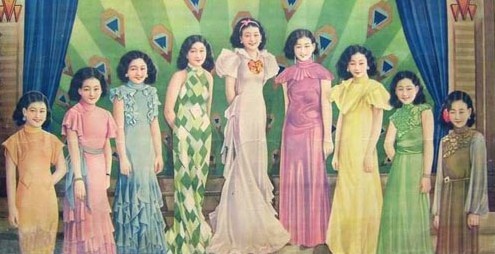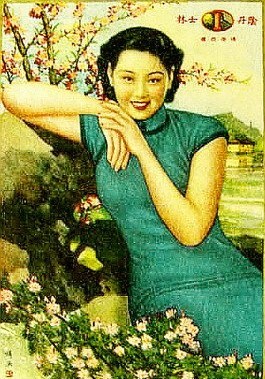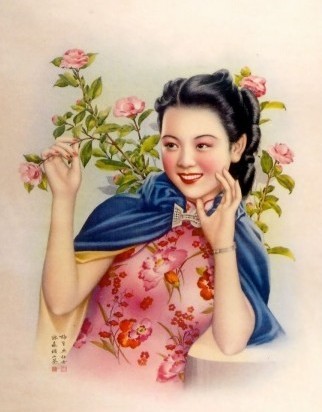| Home > China Feature |
Evolution of Female Beauty and Fashion in China

In ancient China, there were Four Great Beauties-Diaochan, Lady Yang, Xi Shi and Wang Zhaojun [*note] - who were so famed for their beauty that, like Helen of Troy, they could overthrow states and cities. Their beauty has been depicted in countless traditional paintings, but unlike the art that came much later, ancient painting techniques make it hard to tell how accurate these depictions are.
By the end of the 19th century, however, calendar posters had begun to gain popularity in China. In 1914, the revolutionary painter Zheng Mantuo created a painting technique that could vividly portray the lively charm of women at the time.
From the late Qing Dynasty to the Republic of China, marketing and promotional materials that depict female beauty have influenced the ways in which our ideas of beauty have evolved. More importantly, these pictures represent a snapshot of women's lives at the time.

Beautiful Feet
Foot-binding has become one of the most famous aspects of ancient Chinese culture. Bound feet even had a poetic name - golden lotus. Today, there are different opinions about the origin of this painful practice. It had become a fashion during the Song Dynasty (960 — 1279), but reached its peak in the Ming Dynasty (1368 — 1644).
After the first Opium War (1840 — 1842) opened China's doors to Western influence, it also brought with it a fresh perspective on the practice. Slowly, Chinese people began to realize the harm it did to women and society.
Although bound feet were considered beautiful in ancient China, they were usually not shown in paintings.
As the winds of Western culture blew in, some reformers came forward with a proposal to ban foot binding, promote women's education, and change the costume system. But their initial efforts had little effect on the feudal ethical code that was deeply rooted in Chinese society.
What truly played an important role in the abolishment of foot binding was the Hundred Days' Reform (1988) [*note]. The main supporter of the reform, Kang Youwei, strongly opposed foot-binding and other outmoded conventions and customs that oppressed women.
In 1883, Kang and other reformers gathered in Guangdong Province to create the No Foot-binding Draft and later founded the Guangdong No Foot-binding Society in 1895, which was promoted to Shanghai, Tianjin, Beijing and other cities.
In 1901, Empress Dowager Cixi issued the first imperial edict banning foot-binding.
The Revolution of 1911 further fueled the 'natural feet movement'. In March 1912, Sun Yat-sen ordered the Department of the Interior to issue notices to all provinces promoting the abolishment of foot-binding. During the May Fourth Movement (1919), urban women began to regard natural feet as the new fashion. In this way, the painful tradition of over a thousand years was left in the past.
In the 1920s and 1930s, progressive Shanghai advertising artists like Zheng Mantuo and Xie Zhiguang began portraying Chinese women wearing high heels and feminine clothing in their pictures.
Life soon followed art and these pictures inspired modern Chinese women to pursue a new life while copying the latest fashions they saw in the pictures.

Costume Revolution
Thanks to the revolutions and favorable economic tides, the Shanghai of the 1920s and 1930s was a paradise for business people. A boom in advertising materials boosted consumption and women never stopped pursuing the latest fashion styles. Beautiful women wearing figure-hugging cheongsam became icons of the era.
Chinese clothing had a strict hierarchy, which was not abolished until after the Revolution of 1911. After that, things changed fairly quickly and in the 1920s and 1930s, women's dressing in advertising posters became noticeably skimpier.
Cheongsam beauties were undoubtedly the most glamorous image of the time. Originally the traditional costume of the Manchu nationality, Western influences combined with the aesthetic taste of the era to produce a form-fitting dress that enhanced a woman's charms.

Advertising artists and tailors influenced each other in further developing the cheongsam designs. Needless to say, women were eager to copy the glamorous designs they saw every day.
Civilized Marriage and Nuclear Families
The traditional marriage concept in ancient China relied heavily on parents and matchmakers. Romantic relationships among single men and women were strictly forbidden under the feudal ethical code.
With the social revolution and the rise of the feminist movement, women's old outlook on life, ethics and values began to change, as did their views on marriage and family.
On June 7, 1902, a man boldly advertised in a Shanghai newspaper for a girlfriend, specifying that she must have natural feet and possess Chinese and Western knowledge. He declared that if he found her, they would have a new-style civilized wedding.
The May Fourth Movement accelerated the liberation of Chinese women. They longed for more freedom and were increasingly willing to pay the price for it.
Unsurprisingly, this modernization of marriage values was reflected in advertising materials of the time, which began portraying men and women hugging and showing intimacy.
Another important phenomenon was the emergence of civilized weddings and mass weddings. In the 1930s, a simple civilized wedding which combined Eastern and Western traits was the dream of all modern women. Chinese brides in Western-style wedding dresses also began to appear in advertisements.
More over, women no longer wanted to have large families. Families got smaller and smaller as people pursued quality of life. And in smaller families, women could gain a more important status.
Many advertisements of the time showed women living in foreign-style houses with suit-wearing husbands, inducing a yearning for an ideal middle-class life among women of that era.

Art
 more
moreChina Beijing International Diet ...
Recently, The hit CCTV documentary, A Bite of China, shown at 10:40 ...

Exhibition of Ancient Chinese Jad...
At least 8,000 years ago, Chinese ancestors discovered a beautiful...

Longmen Grottoes
The Longmen Grottoes, located near Luoyang, Henan Province, are a tr...

Custom
 more
moreWeb Dictionary
Martial Arts
Tai Chi Master Class Held in Moscow
MOSCOW, June 15, 2016 (Xinhua) -- Students learn from Shaolin ...
Celebriting 70 years' efforts in restoring Mogao...
Work is being carried out at the restoration site of cave No 98 a...
Hong Kong Children's Symphony performs in Seattle
Under the theme of Tribute to the Golden Age, a concert featuring a ...





 print
print  email
email  Favorite
Favorite  Transtlate
Transtlate 








